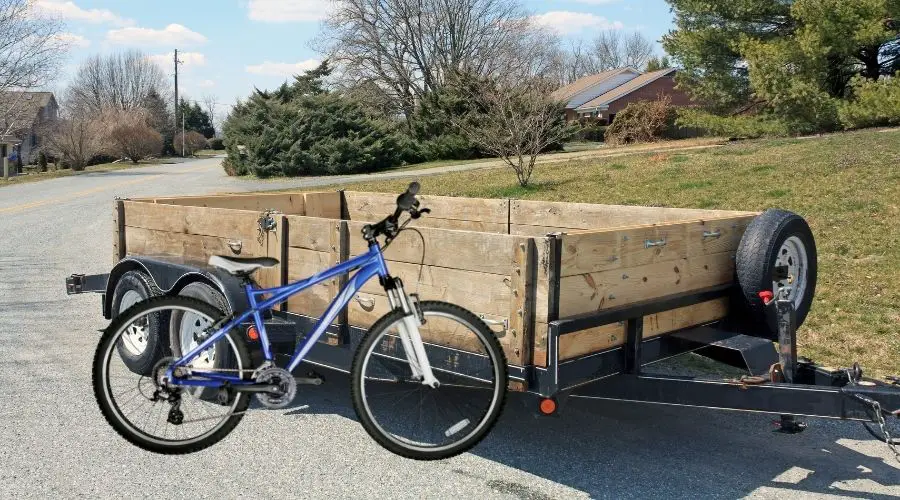Lots of people make the mistake of tying a bicycle on a trailer by attaching ratchet tie-downs to the center of the bike and sides of the trailer.
Unfortunately, while this method feels sturdy, it’s putting too much uneven pressure on your bike frame, and it’s not as stable as it looks. How should you tie down a bicycle on a trailer?
The best way to tie down a bicycle on a trailer is by using soft straps like bungees on the front and sides, a mounted bike rack, and a wheel stabilizer strap. Ratchet tie-downs are helpful if your bungees won’t reach as far as you need them to go. Getting a bicycle secure on a trailer is vital.
Recommended Gear
To see all of my up-to-date recommendations for bikes and cycling gear, check out this resource that I made for you!
Table of Contents
How To Tie Down A Bike On A Trailer
Whether you want to go a few miles or cross country, strapping a bicycle to a trailer is a smart way to transport it.
Once you know how to tie it down securely, you only need to check on it when you make stops.
Below are 5 steps to tie down a bicycle on a trailer:
- Set the bike upright. Bike tires have good grip and a little bit of give, so they’re a great way to transport a bicycle. However, please ensure that they are not overinflated or empty. The added pressure of straps bearing down on the tires can pop them or bend the frame if not properly inflated.
- Next, secure the tires with straps so they won’t move.
- Attach two bungee cords to the front handles. If you prefer, or it is easier, you can go around the fork instead, but you need to attach the two sides of the bike to the front end of your trailer’s two corners. You can accomplish this with help from a friend, or when you’re working alone, by starting out with the cords attached right in front of the bike, then moving each one a few inches to the side, alternating between and keeping the pressure primarily even.
- Once the front end is attached, you can secure the two sides. I’ve seen people connect the seat post to the back but linking to the frame is sturdier.
- Don’t forget to stop and check on your bike periodically if you are taking a more extended trip or moving far away.
There are extra steps when using a rack to help secure your bicycle, but not all bikes need additional security.
For example, when the trip is short, and you won’t be on busy roads, there’s no need for extra effort. So long as you do an excellent job with your bungees, it should be safe.
I’ll also go over the specifics of tying down a handful of bike types and cover how to use racks on a trailer.
How To Tie Down A Mountain Bike On A Trailer
Mountain bikes are among the largest and heaviest of the standard bicycles. As a result, it’s a good idea to place them on a rack designed to hold a bike securely.
You will still need to tie down the front and sides or front and back end of an MTB just as you would if it was freestanding.
However, the added security of a bike rack will help keep it in place on winding mountain roads.
I recommend getting a trailer made for bikes. My favorite is the Tow Tuff 62 Inch 500 Pound Capacity Steel Cargo Carrier Trailer from Amazon.
This small yet mighty trailer is ideal for towing most small machines around, but more importantly, it’s designed to hold bicycles.
You’ll love the adjustable wheel holder and tie-down holes for easy MTB transport. Get yours by clicking right here.
- Convenient Bumper Rack: Effortlessly haul luggage, bikes, furniture, camping gear, and more in this durable and versatile 2-in-1 cargo carrier bike rack from Tow Tuff
- Versatile Cargo Rack: Engineered to accommodate all 2-inch receivers, ensuring a universal fit for a wide range of vehicles, including a strap, tie-down holes, pull-out bar, adjustable wheel cradles
- Durable Bike Carrier: Rugged, heavy-duty steel construction frame boasts exceptional durability, ensuring it can withstand even the toughest conditions; Bike cargo rack does not fold
- Reliable Bike Rack: When used as a bike rack, the adjustable wheel holder and tie-down holes secure the bike(s) in place with wheel cradles that fit most bikes and hold up to 4 bikes
- Efficient Cargo Rack: Supports up to an impressive 500 pounds, making it ideal for handling heavy loads; Measures 27 inches long, 62 inches wide, and 3 inches tall
How To Tie Down A Road Bike On A Trailer
Road bikes are small and lighter weight than some of their cousins.
While you don’t need any special techniques to tie down this style, it’s essential to make sure you don’t leave too much ‘wiggle room’ on a small bike, particularly when traveling on the highway or in a very windy area with an open trailer.
Tie-down small bike styles at the front and rear for short trips. However, you should secure them in the middle for longer trips or use a bike rack to help keep them in place if the trailer is open to the air.
How To Tie Down A BMX Bike On A Trailer
BMX bikes are built smaller like road bikes. Secure them at six points, front, rear, and sides, with less give than you would for a larger bicycle.
It’s imperative to make sure this style has properly aired up tires since they are usually smaller in diameter, and you don’t want to damage them in transit.
Some people recommend using a chock on bicycles, but I find that this is overkill if you are already using a strap to secure the wheels in place, and these are more common for transporting motorcycles or cars.
However, if you’re tying down your BMX with the trailer parked on a steep hill, you could use a wedge of wood or metal to hold it in place while you secure straps.
How To Tie Down 2 Bicycles On A Trailer
If you don’t have an enclosed trailer, I recommend using bungee cords to secure the two bicycles together and secure each bike as though it was one-half of a single bicycle.
So, the right-side bicycle would be connected to the righthand side of the open trailer and the left bike.
In this case, you want to bungee the front, back, and middle of each bicycle, rather than using four points as you would for a single bike.
That said, when transporting two or more bicycles, it may be best to use an enclosed trailer.
Looking around the inside of an enclosed trailer, you may notice that it’s not as easy to connect bungee cords because there are walls instead of sides.
Although there are several ways to add steel connectors to the floor, I recommend a more straightforward solution.
Steadyrack Bike Racks from Amazon are easy to install, and they hold your bicycle securely in a vertical position against the wall.
You can attach a Steadyrack permanently, and it will only take up a minuscule amount of space on the wall when it’s not occupied with a bicycle. Get your own Steadyrack delivered fast by clicking here.
- Built To Last – Made from steel and UV treated plastic, our racks are strong and built to last, holding up to 77Lb.
- No Lift – Simply balance the bike on its rear wheel and push it into the rack – there’s no heavy lifting required.
- Saves Space – Unlike bike stands, hooks or pulley systems, our racks have a unique 160-degree pivot feature.
- Fender / Mudguard? – If your bike has a fender/mudguard, this bike rack is not suitable for your bike. Check out the Steadyrack eBike Rack instead!
- Wall Structure – Installation kit/fixings are designed for masonry and stud wall only. Plasterboard/Drywall/Gyprock mounting alone voids our warranty and is not recommended.
Even on a rack, it’s a good idea to run a bungee cord to attach the bicycle to the rack. Ensure that you connect to tie down to a sturdy part of the frame or fork of the bike rather than tuning it through the tires.
Taking this extra step to tie your bike to a rack will keep it from coming off the wall of your closed trailer. Check out the video below to see how a Steady Rack works.
Helpful Tips To Know About How To Tie Down A Bicycle On A Trailer
Whether you use an installable rack, a built-in rack, or none at all when tying down your bicycle, it’s essential to get your bungee cords on tightly.
A bike should only have the slightest amount of play when secured for transport.
Here are more helpful tips to know about how to tie down a bicycle on a trailer.
- Ratchet tie-downs are helpful if your bungees won’t reach as far as you need them to go. You can quickly secure your ratchet tie-down and use it as an extension to attach your bungees to the sides of the trailer.
- Before going anywhere with a bicycle on a trailer, make sure your trailer is legal. Most areas require trailers to have working backlights. Depending on the size of your trailer and the place where you live, you may also need a license plate and registration for the trailer, even when you own it and you’re only moving a bicycle. You can find a state-by-state list of these policies right here.
- Most trailers have plenty of places to tie down your bike. However, you can install additional large diameter bolts on the floor if necessary.
Final Thoughts
Getting out for a good ride on your bike is fun and healthy, but sometimes you want to go a little further.
Whether your bike needs to go a few miles or a few hundred miles, it’s crucial to tie it down securely on a trailer.
Open trailers are the most accessible place to tie a bicycle. Fortunately, you can still use a closed trailer if you have the right equipment, like a wall mount bike rack.
However, it would be best if you still tied the bike down while you’re in motion, even when using a rack to hold the wheels.



